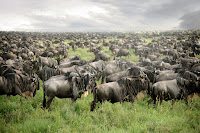As natural wonders go, perhaps the most awe-inspiring is the annual migration of 1.2 million wildebeest flowing across East Africa’s vast Serengeti grassland. It would be a tragedy to lose these animals. But we almost did in the mid-20th century when, decimated by disease and poaching, their numbers crashed to 300,000.
The consequences of that collapse were profound. Much of the Serengeti ecosystem remained ungrazed. The accumulating dead and dried grass in turn became fuel for massive wildfires, which annually burned up to 80 percent of the area, making the Serengeti an important regional source of carbon dioxide emissions.
Then, conservation programs to eradicate disease and crack down on poaching led to the recovery of the wildebeest, restoring the grazing system and reversing the extent of the large-scale wildfires. Grazing now causes much of the carbon in grass to be released as animal dung, which is in turn incorporated by insects into soil reservoirs that are not prone to burning. The Serengeti ecosystem has now reverted to a carbon dioxide sink so large that it is estimated to offset all of East Africa’s current annual fossil fuel carbon emissions.
The wildebeest decline and recovery taught a valuable lesson, not only in how easy it is to loose an iconic animal species, but, more importantly, how the loss of a single species can have far-reaching ramifications for ecosystems — and the climate. Mounting evidence from ecological science is showing that one or a few animal species can help determine the amount of carbon that is exchanged between ecosystems and the atmosphere. It’s not that any single animal species by itself has a huge direct effect on the carbon budget. Rather, as the wildebeest case shows, by being an integral part of a larger food chain the species may trigger knock-on effects that grow through the chain to drive significant amounts of carbon into long-term storage on land or in the ocean.
Recent studies have shown, for example that the loss of important predators — from wolves in boreal forests to sharks in seagrass meadows — can lead to growing populations of terrestrial and marine herbivores, whose widespread grazing reduces the ability of ecosystems to absorb carbon. Still, the impact of biodiversity loss on the climate system is underappreciated, and reversing that loss is rarely considered as an effective tool to help slow the buildup of atmospheric carbon dioxide.
Read more at How ‘Natural Geoengineering’ Can Help Slow Global Warming

No comments:
Post a Comment